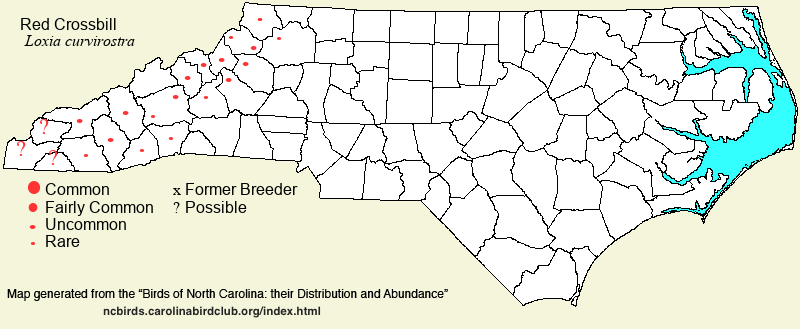 |  |
|
Red Crossbill - Loxia curvirostra FRINGILLIDAE Members: | Search Common: Search Scientific: |
|
|
|||||||
| General Comments | The Red Crossbill is another of the erratic "winter finches" in the East. Unlike with most of these winter finches, it does nest in North Carolina (in the higher mountains), though the bulk of the breeding population occurs in the coniferous forests of southern Canada and the northern and western United States. In the winter, Red Crossbills typically remain only in the state's mountains, but every handful of years there is a moderate influx of birds to the remainder of the state. Sadly, such influxes have waned in recent decades; in the 1970's, the species was not unusual even near the coast, but in the past two decades, the species has been hard to find downstate in winter, though there was a notable incursion in winter 2020-21, and a lesser one in 2022-23. Birds are almost always found in conifers, feeding on seeds; thus, pine stands are the usual habitats in winter, but in summer in the mountains, the birds are mainly found in spruce-fir stands, and less so at stands of White Pines (and other pine species) and (formerly) stands of hemlocks. Several recent studies have identified about 12 different song/call types within the species (as of 2023), and a few papers have suggested that some or all of these could represent full species. At least two song types apparently occur in North Carolina. The breeding population in the Southern Appalachians appear to be Song Type 1; this form is supposedly mainly non-migratory and thus remains in the NC mountains year-round. Those that occur in winter in the Piedmont and Coastal Plain are (based on current thinking in 2023) mainly Song Type 12, but there have been experts indicating that Song Types 2 and 3 have also been found. All of these judgments are based on audio recordings of songs and calls. As expected, many birders feel that all of this is very subjective, and even though one Song Type has been elevated to full species -- Cassia Crossbill in Idaho (mainly) -- it appears unlikely that any other types, at least in the East, will be split into newly named species any time soon, owing to very subtle vocal and physical character distinctions and to the continuing uncertainty of the number and distributions of the song types. | ||||||
| Breeding Status | Breeder | ||||||
| NC BRC List | Definitive | ||||||
| State Status | SC | ||||||
| U.S. Status | |||||||
| State Rank | S3B,S3N | ||||||
| Global Rank | G5 | ||||||
| Coastal Plain | Winter visitor, and apparently accidental breeder; declining. Currently, very rare to rare across the entire region, erratic from winter to winter; no records at all in several recent winters. More likely in the western and northern portions, and very scarce near the southeastern coast. Mainly Nov to Feb. Three juveniles and two adults were seen at Weymouth Woods Sandhills Nature Preserve (Moore) on 15 May 1976, likely representing a local nesting. Peak counts: 25, Kitty Hawk Woods Coastal Reserve (Dare), in late Dec 2020; 14, Bodie Island (Dare), 30 Dec 1969. | ||||||
| Piedmont | Winter visitor, and accidental breeder; declining. Currently, rare and erratic in winter; formerly rare to uncommon (in the 1970's); practically no records in some recent winters. Odd was the occurrence of a tight group of 11-12 birds at McDowell Prairie Preserve (Mecklenburg) from 7 Dec 2024 - 12 Jan 2025 -- the only report for the entire province that winter! Apparently nested at Raleigh, where three birds, including one that was about 5 weeks old, were collected at Lake Johnson on 6 May 1967. Close to the Blue Ridge Escarpment, 13 seen at Green River Game Land (Polk) on 28 Apr 2024 suggests local nesting there. Peak counts: 60, William B. Umstead SP (Wake), 22 Nov 1969. | ||||||
| Mountains | Summer resident at higher elevations, and winter visitor to all of the region. In summer, rare to locally uncommon at higher elevations, mainly at spruce-fir forests, generally above 4,500 feet; very rare to rare and erratic in summer down to about 3,000 feet. Summer reports do occur below 3,000 feet, but documentation of nesting is needed to prove nesting at such low elevations, if it occurs at all. Breeding populations seem to be stable. At other seasons, rare and erratic at lower and middle elevations, with numbers declining in recent years. Of considerable interest was a pair seen copulating and nest-building at Carver's Gap (Mitchell) on 12 Feb 2022, seeming very early in the year for such an activity. Peak counts: 100, Black Balsam, along the Blue Ridge Parkway, 5 Jun 2004. | ||||||
| Finding Tips |
Though the species is erratic in summer, it has been somewhat regular in recent years at Mount Mitchell SP and along the Blue Ridge Parkway within a few miles of the entrance road to the park. The parkway in the vicinity of Devils Courthouse, and as far northwest as Richland Balsam, can also be fairly good. Even so, it is easily missed in a day or two of birding in the spruce-fir zone, and even then often all one gets is a view of birds flying overhead giving the "jip-jip" call notes. Seeing birds perched may require much patience! ** | ||||||
| Attribution | LeGrand[2025-10-24], LeGrand[2025-05-09], LeGrand[2024-08-06] | ||||||
| NC Map Map depicts all counties with a report (transient or resident) for the species. | Click on county for list of all known species. |
| NC Breeding Season Map Map depicts assumed breeding season abundance for the species. |  |